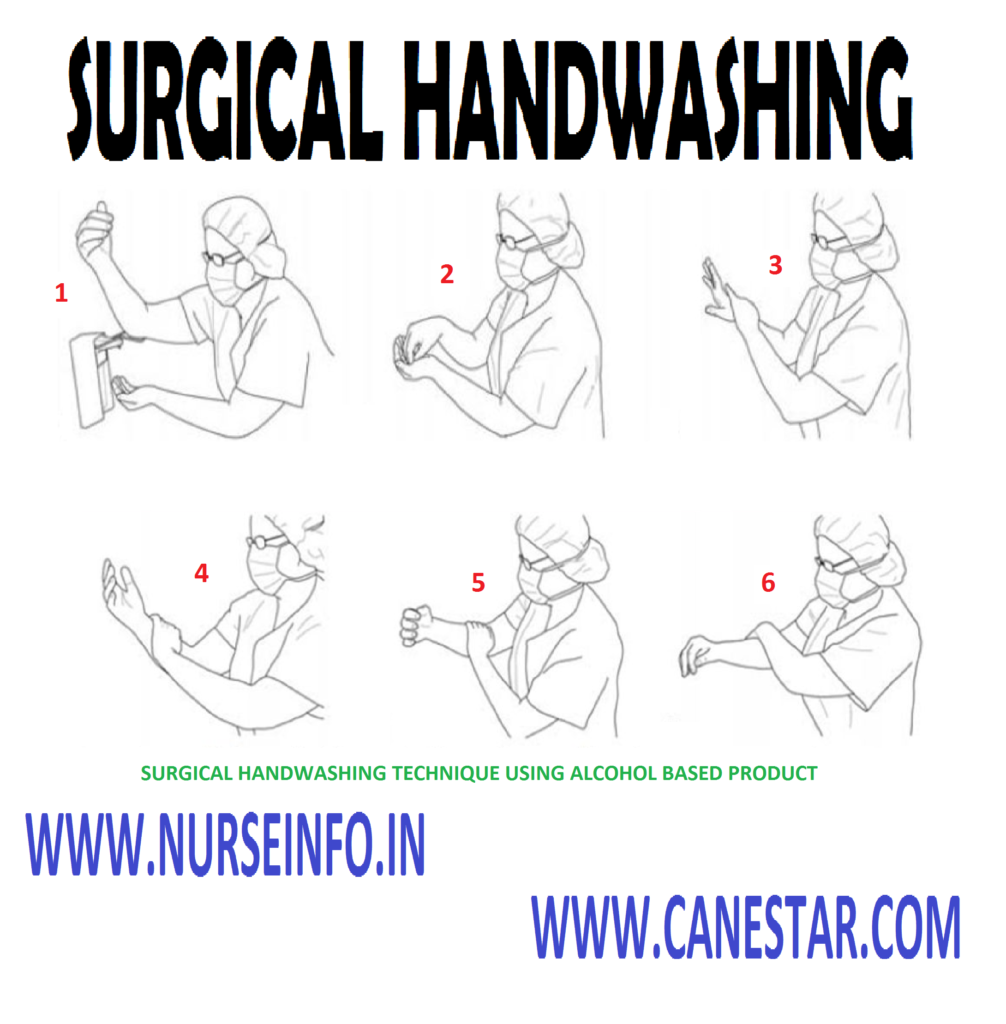SURGICAL HANDWASHING
Surgical handwashing, also known as a surgical scrub, is a specialized and thorough hand hygiene procedure performed by healthcare professionals before entering the operating room or engaging in surgical procedures. The purpose of surgical handwashing is to eliminate or reduce the number of microorganisms on the hands and forearms to prevent the introduction of infections into the sterile surgical environment. Here is a step-by-step guide for surgical handwashing:
Surgical Handwashing Procedure:
1. Remove Jewelry and Accessories:
- Begin by removing all jewelry, including rings, watches, and bracelets, from your hands and wrists. Jewelry can harbor microorganisms and interfere with proper handwashing.
2. Pre-rinse:
- Pre-rinse your hands and forearms under running water. This helps to remove loose dirt and debris.
3. Apply Antiseptic Solution:
- Dispense the appropriate antiseptic solution or surgical scrub solution onto your hands and forearms. Common antiseptic solutions include chlorhexidine gluconate or povidone-iodine.
4. Scrub the Fingernails:
- Use a nail brush or the bristles of your scrub brush to clean under and around the fingernails. Pay attention to each finger and the area around the nails.
5. Scrub the Hands and Forearms:
- Rub your hands and forearms with the antiseptic solution for the recommended duration, often ranging from 2 to 5 minutes. Follow a systematic scrubbing pattern, including the backs of hands, between fingers, and up to the elbows.
6. Pay Attention to Specific Areas:
- Focus on high-risk areas such as the fingertips, the webbing between fingers, and the wrists, as these areas are more prone to contamination.
7. Keep Hands Elevated:
- Keep your hands elevated during the scrub to prevent the runoff of water from contaminating your scrubbed hands.
8. Rinse:
- Rinse your hands and forearms thoroughly under running water to remove the antiseptic solution. Ensure that water flows from your fingertips towards your elbows.
9. Repeat If Necessary:
- Some surgical scrubs may require a second application of the antiseptic solution and a repeat of the scrubbing process. Follow the specific guidelines of the facility or procedure.
10. Dry Hands with Sterile Towel: – Dry your hands and forearms using a sterile, lint-free towel. Pat them dry rather than rubbing.
11. Don Sterile Gown and Gloves: – After completing the surgical scrub, don a sterile gown and gloves without contaminating the scrubbed hands.
12. Maintain Sterility: – Throughout the surgical procedure, healthcare professionals must maintain sterility by avoiding contact with non-sterile surfaces and minimizing unnecessary movements.
Surgical asepsis: the hands should be thoroughly cleansed for about 3 to 5 minutes (in operation room, hands are scrubbed up to 10 minutes)
Surgical Scrub
- Wet hands and forearms
- Apply soap (containing 3% hexachlorophene) to make a good lather
- Clean under nails, which should be kept very short (30 seconds)
- Rinse thoroughly
- Apply soap to hand and arms again
- Scrub with brush so that every area receives 15 to 30 strokes
- Add small amount of water frequently and use just enough detergent to maintain lather
- Rinse the arms and hands
- In rinsing keep palms higher than the elbow so that water does not run over palms from the arms
- Dry on a sterile towel moving from the palms to the arms
General Instructions
- When washing hands, they are held above the level of the elbow (in surgical asepsis the elbow are considered more contaminated than the hands)
- The water should run from least contaminated are hands to the area of great contamination (elbows)
- It is important to put soap well and scrub with a brush and rinse thoroughly with water several times
- A sterile towel is used to wipe the hands and arms. Starting from the palms to the elbows
- The gown is to worn by the infected person when he is transported outside his room. The gown prevents the patients contaminated clothing from touching clean areas
- The gowns are worn by the nurses who caring for the persons whose resistance to infection is diminished, e.g. premature babies
- The outside of the gown is considered to be highly contaminated and the inside of the gown is considered to be clean
- If the gown is to be re-used, hang the gown inside the patients unit with the contaminated side folded out
- Hang the gown outside the patients unit with the contaminated side folded in


